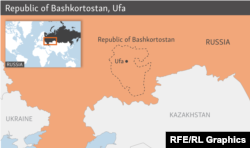UFA, Russia -- Despite multiple pronouncements from high-level and local officials, Chinese investment has been stalling for years in Russia’s Bashkortostan -- a Russian republic located some 1,300 kilometers east of Moscow.
As ties have reached new heights between Beijing and Moscow -- with Chinese President Xi Jinping and his Russian counterpart, Vladimir Putin, declaring a “no limits” partnership in February -- local authorities, often at Moscow’s urging, have sought and trumpeted upcoming Chinese investment projects in their regions.
But this embrace of China has looked far different on the ground in more rural areas like Bashkortostan, where an investigation by RFE/RL's Tatar-Bashkir Service found that Chinese projects rarely reach the implementation stage.
These projects have also faced an array of setbacks -- from budget issues due to the COVID-19 pandemic to local protests due to concern over lax environmental standards for ventures and sweeping Western sanctions against Russia following the Kremlin’s invasion of Ukraine.
“The local government supports all initiatives that are related to attracting [Chinese] money to the republic, but unfortunately it all ends with talk,” Vsevolod Spivak, an economist based in Ufa, the capital of Bashkortostan, told RFE/RL. “This seems to be due to inefficient planning for projects and a general lack of understanding of how the economy here really works. It’s big words that often lead to nothing.”
Fallout from Russia’s war in Ukraine could also have a particularly detrimental effect on the already limited business climate in Russia for Chinese investors as they navigate sanctions and a less-attractive Russian economy that is predicted to contract by at least 10 percent in 2022 and grapple with soaring inflation and unemployment.
In Bashkortostan, the majority of Chinese-backed projects have consisted of building transport and rail links along Beijing’s globe-spanning Belt and Road Initiative (BRI) while investing in factories for construction materials, like cement.
They wanted to bring a Chinese cement plant to us, which is normally outsourced [from China] to developing countries. But they wanted to build it here in Russia, so you can gather to what level we have sunk.”-- Nasip Sakmarov, activist from Sibay
The Western sanctions, which are already showing signs of scaring off Chinese investors from the Russian market, could further impede the already troubled projects in Bashkortostan and other parts of the country that are far-removed from the technology and energy sectors that traditionally attract Chinese capital.
Inbound rail-cargo shipments have already all but frozen along the 12,000-kilometer corridor stretching from China’s eastern shores to Western Europe that uses Russia as a principal rail line.
Meanwhile, Moscow’s invasion has left Chinese companies with a global reach cautiously distancing themselves from Russia by scaling back operations and freezing planned projects due to fears of being hit by secondary U.S. sanctions.
“These routes were [one of] the most successful sides of the BRI in Europe and, without them, China will lack a BRI success story [there],” Andreea Brinza, vice president of the Romanian Institute for the Study of the Asia-Pacific, told RFE/RL, noting that Beijing is already looking to rely more on southern transport routes through Central Asia and the Caucasus for the BRI.
Stalled Vision And A Public Backlash
Relations between China and Russia have improved markedly since 2014 when the Kremlin declared it would pivot to Asia in the wake of Western economic sanctions over Moscow's annexation of Crimea and Russia's role in the war in eastern Ukraine.
That led to a flurry of deals over the years that were mostly connected to Chinese investments in Russian extractive resources, such as its lucrative oil and gas sector. But it has also seen an increase in overall trade, which reached a new high of $146.9 billion last year.
At the local level, this means that, despite many problems in attracting Chinese investors, China is still the main trading partner.
In Bashkortostan, this dynamic has led to many Chinese-backed projects being announced -- from a new shopping center where billions of dollars were pledged to multiple ventures in the agricultural sector and several factories producing construction materials -- that still have not moved forward and exist only on paper.
One such project is a cement plant in Sibay, a town of 62,000 people that is 464 kilometers from Ufa.
The proposal has been on the books in some form since 2017 and the main Chinese investor, Sichuan Junhe Environmental Protection Company, opened an office in Sibay and pledged to invest $154 million (12.8 billion rubles) into the plant and generate 200 new jobs for the community.
But those plans appear to be on hold. An RFE/RL Tatar-Bashkir Service correspondent visited Sibay and found the offices closed and that the company’s signage had been removed.
Airat Murzagaleev, deputy head of the press service and Information Department for the Republic of Bashkortostan, told RFE/RL that the plans are currently frozen. He said the “investor’s plans were affected by the coronavirus pandemic.”
The attractiveness of the Russian economy has obviously already fallen. But China is one of the few countries whose government is ready to enter the empty niches of our market, despite [the] risks.”-- Economist Vsevolod Spivak
Rustem Afzalov, the mayor of Sibay, told RFE/RL that he will continue to pursue investment from Chinese businesses and that the cement plant is still a priority for the region that will hopefully resume in the future.
Should the project pick up again, it is likely to continue to face protests from activists. The Chinese-funded plant was strongly opposed by locals because of environmental concerns about the factory and has faced a continual backlash since it was announced in 2017.
Nasip Sakmarov, a longtime activist from Sibay, told RFE/RL the plans for the Chinese cement plant brought together people from various walks of life to push back against its construction due to pollution concerns. Many people are hoping for higher-level investment in the region that could spur development, not factories for materials like cement, he added.
“They wanted to bring a Chinese cement plant to us, which is normally outsourced [from China] to developing countries,” Sakmarov said. “But they wanted to build it here in Russia, so you can gather to what level we have sunk.”
Silk Road Setback
How things change in the aftermath of Russia’s invasion of Ukraine and the hit that the war has brought to its economy is not fully known.
Despite criticism of the Western sanctions that were placed on Russia, Beijing has been quietly enforcing the measures and moving cautiously to avoid any violations.
But Rustem Shayakhmetov, an economist and social activist who has worked across Bashkortostan, told RFE/RL that he doesn’t expect any major investment projects to come to Russia in the near future.
He says this is partly due to authorities in Bashkortostan -- and Russia as a whole -- not offering profitable or attractive offers to Chinese investors beyond its energy and mineral sectors, adding that despite the attractiveness of the Chinese market, there are few people in Ufa or elsewhere in the region who speak Chinese and have a deep knowledge of the country.
Despite criticism of the Western sanctions that were placed on Russia, Beijing has been quietly enforcing the measures and moving cautiously to avoid any violations.
Chinese state energy giants have in recent weeks set up task forces to evaluate their multibillion investments in Russia and major corporations like Huawei have furloughed large portions of their Russian staff as the company evaluates how it can navigate the new sanctions.
But many experts also note that while China is unlikely to prop up the Russian economy, it is expected to make opportunistic moves -- such as buying up discount oil and acquiring new market space left by Western companies who have withdrawn from the country -- once it becomes clear how to better comply with the sanctions.
“The attractiveness of the Russian economy has obviously already fallen,” said Spivak, the Ufa-based economist. “But China is one of the few countries whose government is ready to enter the empty niches of our market, despite [the] risks.”










